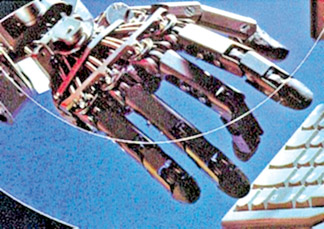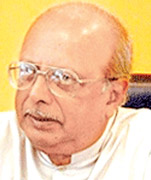|
Export sector needs high-tech goods with value
addition:
SL, a knowledge hub in Asia soon
By Dhaneshi Yatawara
"Our objective is to increase high-tech component of exports from 1.5
p.c. to 10 p.c. by 2015," Prof. Vitharana said.
Today, Sri Lanka has only about 4,000 researchers. To make full use
of our natural resources we should have 18,000 researchers with
doctorates.

 |
|
Prof. Tissa Vitharana |
Sri Lanka is planning to become a knowledge hub for the region. But
are we, as a country doing enough? What percentage of our knowledge are
we using for the development of the country?
Supporting the Government's full vision of making the dream of a
knowledge hub a reality a new policy is in action now interlinking the
high-tech science research world with the realities of the modern
business world. This if it turns out to be ever green it would
undoubtedly be a gold mine.
"We plan to develop Sri Lanka as a knowledge hub. But today we see
the focus is mainly on Information and Communication Technology. Even in
that we are dealing only with the existing knowledge and very little new
knowledge is created through the mechanism.," said Senior Minister for
Scientific Affairs, Professor Tissa Vitharana. Explaining the urgent
need for the country to advance in a path we are good at the Senior
Minister said, "We have to develop other technologies that would
generate a lead to high value addition to our raw materials which are
our natural resources, so that we become exporters of high-tech goods
and it will help us to compete successfully in the world market."
"We need to have a rapid economic development to emerge from poverty
and solve the problems that affect the people as an under developed
country," Prof. Vitharana said.
What is happening with the Sri Lanka Institute of Nanotechnology
(SLINTEC)? Wasn't this the sole reason to establish it? The Senior
Minister said this is a step taken further from just being a
public-private partnership which actually became a miracle. Sri Lanka
needs to incorporate more high-tech knowledge to the industries for a
better performance. We need to improve our exports and the contribution
of high-tech goods with a value addition need to be increased, said
Prof. Vitharana adding that we must go beyond the raw material exporting
country from the developing world using a best tool we have - the human
resource with excellent scientific knowledge.
In the recent past, Sri Lanka managed to prove this within less than
two years establishing SLINTEC by applying for the patent rights for
five innovations. Today the number has increased to seven. Yes, two more
innovations have applied for patent rights. "At the SLINTEC we are using
nanotechnology to add high value addition to many products that we
import. Similarly we have other scientific fields such as biotechnology,
electronics, mechatronics to venture into." Prof. Vitharana said.
Countries like Japan, Singapore, China and Malaysia of our region
emerged from almost nothing to a technically advanced state
incorporating more of their science and research into national
development. "They have been able to do so increasing the high-tech
component of their exports. In Japan 85 p.c. of exports are high-tech
goods. In South Korea it is 70 p.c. and in Singapore it is 60 p.c. and
at present Thailand has increased to 27 p.c. For Sri Lanka it is only
1.5 p.c. So I have presented to the Cabinet the National Science
Technology Innovation Policy which the Cabinet accepted, to lead to
rapid economic development with the focus on high-tech," he said. "And
our objective is by 2015 to increase the high-tech component of exports
from 1.5 p.c. To 10 p.c.," Prof. Vitharana said.
In Sri Lanka, in the Government sector there are 31 research
institutes and 47 science based faculties in the university system,
according to the Senior Minister. "They are doing research in isolation.
It is not being effectively coordinated, monitored and focused on
producing high-tech goods and services that are marketable," he said.
"The problem is that we did not have a proper mechanism. When I was
appointed as the Senior Minister for Research and Development
incorporating research and development to national development,
monitoring and evaluating was in my mandate. Being the Senior Minister I
was empowered to act to bring the national strategy and that was my job.
This was the start in organising the Cabinet Paper for the government
initiated strategy," he said.
Were there any previous attempts by the Government to bring about an
attempt to establish a mechanism for Science and Technology Innovations
to be successfully incorporated into the national development drive?
"This is the first time we as a country are trying to take this one step
ahead.
There is duplication in research efforts in many areas. For ceramics,
research is done in the Industrial Technology Institute and in several
university departments. But they are completely unaware and unrelated to
each other. Priority areas that needed research are being neglected,"
explained Prof. Vitharana on the present situation of Sri Lankan
research field. "We are setting up this platform firstly in terms of all
our natural resources - land and sea and human resources. The idea is to
bring all this together to achieve maximum value addition," he said.
Why do we need this? The Senior Minister explained, "For example, in
the rubber industry there is a certain amount exported as rubber tyres,
and we produce a small amount of rubber gloves. But we have hardly
broadened the capacity. There are numerous other products that can be
manufactured from rubber.
There are many rubber products used in equipment manufacturing around
the world which are in mass use. We have the potential to be a
successful producer. We need to find out what the market possibilities
are. And then diversify so we start having value additions to meet those
market needs," he said. "Raw material is the starting point of a value
chain. We are now trying to convert raw materials like Ilmonite from
Pulmudai to be converted into Titanium dioxide through nanotechnology.
Titanium dioxide can be turned into titanium which is widely used in
high-tech sophisticated areas such as aeronautics, space sciences as a
high value added product. So now we are starting actually at the low end
of the chain.
"Another possibility, for example, is silicon. It is widely used in
cellular phones and many other equipments used in telecommunication,
computers and other high-tech gadgets. This is also the core element in
manufacturing solar cells. Silicon dioxide is used in trapping solar
energy. But we are not contributing to that. "We have to identify such
potential areas and then focus research on those lines to suit us and
manufacture new products according to the requirements of the market
niche in identified value chains," he said. "We have the potential for
success in this effort. We have to have a proper data base with the
existing resources, marketable products that can be manufactured with
those and the end result of those products in the world market.
"Parallel to this, we need to build up the capacity in research and
development to achieve the targets. Most of the laboratories in the
country were established during British era and today they need to be
upgraded to suit today's needs."
"We need labs conforming to international standards. Hardly any
laboratory in the country is up to this standard. With our limited
financial resources we have a difficulty in achieving this. We cannot
bring the 31 labs and 47 science based faculties to this standard. So
what the policy suggests is to build one advanced technology centre.
This is what we are setting up now at Homagama as the science park. It
initially focuses on nanotechnology but will spread to other areas of
science as well. Working around nanotechnology, other fields such as
biotechnology and electronics can be developed too. Nanotechnology has
an impact on many other fields of technologies. Using this factor we can
develop to the level we expect," he said.
"In my view Asia should be the centre for biotechnology as we are
rich in bio diversity. Sri Lanka is a hot spot for bio diversity," he
said. We have plant material which can be the source of pharmaceuticals,
cosmetics which are now in increasing demand. In today's world people
are turning away from synthetic medicines to natural ones. So we have to
develop biotechnology to exploit the possibility of achieving the
maximum value addition. This will not only be for Asia but for Sri Lanka
as well. We have the resources to become an advanced rich country.
"First we need to focus on capacity building. If we have one good
world-class laboratory in nanotechnology with a single lab based on
biotechnology we are upgrading our research capacities. To upgrade human
resource we need researchers with doctorates. Today in Sri Lanka we have
only about 4,000 researchers. To make full use of our natural resources
we should have 18,000 researchers with doctorates, according to average
world figures. Thus gearing up our education sector is vital. "Our
upgraded facilities need to compliment the businesses. We need to have
cutting edge science and technology to have world-class research and
innovations. Our industrialist can financially assist these researches
targeting to develop their industries," Prof. Vitharana said.
The system we are establishing through the ministry will coordinate
scientific research and industries. The Government is implementing this
policy. "We are already establishing a new office in Colombo for this.
And hoping soon to start activities in giving a boost to the country,"
Prof. Vitharana said explaining the new leaf the country is going to
turn.
|



